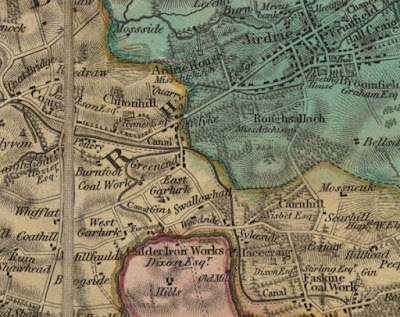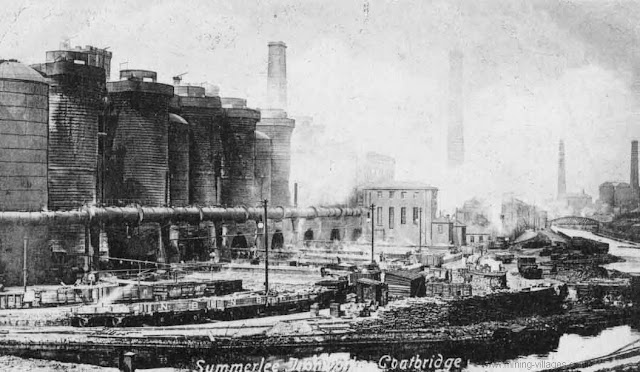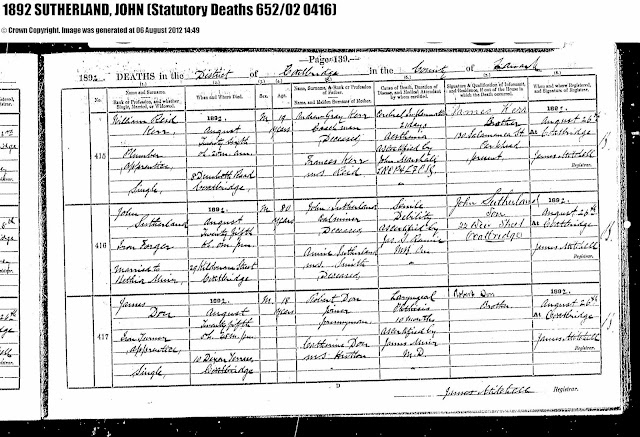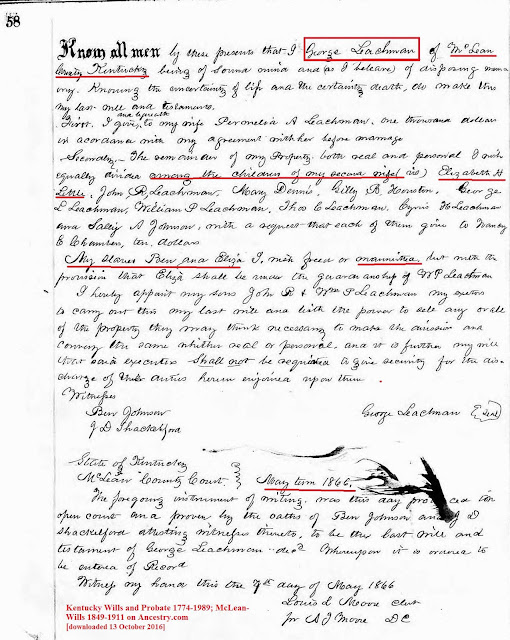Fire, Smoke and Soot:
Life in the City of Coatbridge/Airdrie, Scotland
John Sutherland 1813-1892
Bethia Muir: 1815-1894
Margaret Sutherland Shields, Bruce’s second great
grandmother, was born May 25, 1837 in the town of Coatbridge in Lanarkshire,
Scotland. Her parents, John Sutherland and his wife Bethia Muir Sutherland, had
grown up in the area. The years after Margaret’s birth saw dramatic changes in
both the city of Coatbridge and in her parents’ circumstances.
John Sutherland came from humble beginnings and moved up in
the world through hard, brutal work in the Coatbridge area. According to
information John Sutherland provided on census records, he was born around 1812
or 1813 in either Barony, Old Monkland or Rutherglen, all towns or parishes in Lanarkshire
near Glasgow. His father, John Sutherland, was a coalminer. His mother was
Annie Jean Smith. He had several siblings.
 |
| Old Monkland Parish, 1816 |
John married Bethia Muir in June, 1834. She was the daughter
of Robert Muir and Margaret Anderson Lauder of Old Monkland. She was born
October 29, 1815; the birth record states that at the time, her father was
working as a weaver.
John Sutherland had followed his father into the mines. The
1841 census lists him as a coal miner, with the family, now including two
children, John, 6, and Ann, 2, (Margaret’s whereabouts are unknown. She would
have been age 4) living at “Allan’s Place, Langlone” in the Old Monkland
parish.
According to the 1851 census, John Sutherland had completely
changed careers at some point during the 1840s. In 1851, he supposedly was
working as a bookseller—quite a contrast to coal mining. The family, now with
six surviving children, was living on Church Street in Old Monkland. I have
some doubts about the accuracy of his occupation—could this be a transcription
error?-- but the family seems to be moving up in the world a bit.
By 1861, the family’s fortunes were definitely improving.
They now lived in a home with a name—The Old Manse in New Monkland, and John’s
new occupation was “ironstone centresictor”. I have no idea what a
“centresictor” might be, nor does Google or the dictionary. I suspect this is a
transcription error—perhaps ironstone contractor? I suspect he was brokering
the sale of iron ore to foundries for processing.
I was able to track down photos of the Old Manse. There were
two homes by that name, both quite large and grand for the area. The first was
torn down around 1870 or shortly thereafter, so I believe the photo of this
original home shows the building the Sutherlands called home in 1861, the year
Margaret married Thomas Shields.
By 1871, the family had relocated to a home at 60 WellWynd
in Airdrie, and John Sutherland was listed as an “iron forge master”, which
could indicate he was the owner of the business or at least a manager. According
to Ruth McNiven her grandmother Margaret’s family owned a foundry in the town
of Airdrie, and were quite wealthy. She said the Shields boys could ride their
bicycles around the Sutherland billiard room. As the 1871 census shows Margaret
and Thomas Shields and their five young children also living at 60 WellWynd,
the Shields boys would have had many opportunities to ride around there.
 |
| 1858 Airdrie Ordnance Survey Map showing Wellwynd and the Airdrie Foundry |
I have tried to find information about the foundry. Histories of the area describe several foundries in and around Airdrie, but the Sutherland name has not turned up in connection with any of them. However, another Ancestry tree that includes the Sutherlands connected the Airdrie Iron Foundry to them, posting the following document, which I believe was a stock share of some sort.
Note that the document has an address, 72 WellWynd, printed
at the top. Interestingly, this is just down the street from the Sutherland
house. It would make sense that John would live near his business. In addition,
the document references a Smith family member. As I mentioned earlier, John
Sutherland’s mother was a Smith. Perhaps he was related to the foundry’s owner
or previous owner.
An ordnance gazetteer from 1885 has an entry for the Airdrie
Iron Foundry, stating it was owned by David Smith. As I have been unable to
identify Annie Jean Smith Sutherland’s extended family, I don’t know if David
Smith is a relative or not. He may have purchased the foundry from the
Sutherlands, as John Sutherland was retired by that point.
 |
| Ordnance Gazetteer entry for Airdrie Iron Foundry |
So what was this area of Lanarkshire like in the mid to late
1800s? Airdrie lies just outside the larger town of Coatbridge, and both
communities were only ten miles from Glasgow, with Old and New Monkland in
their midst. The entire area is now part of the greater Glasgow metro area, but
in the mid-1800s, they were all still separate communities. Here is a
description of Coatbridge in 1846 by Samuel Lewis:
“Coatbridge, a village, in the late quoad sacra parish of
Gartsherrie, parish of Old Monkland, Middle ward of county Lanark, l 1/2 mile
(NW) from Airdrie, containing 1599 inhabitants. This is a very thriving place,
which has more than doubled in extent and population within the last fifteen
years, owing to the extension of the iron trade in the district, and to its
being in the vicinity of valuable coal-mines; the Dundyvan and Summerlee
iron-works in the neighbourhood are conducted on a large scale, and afford
employment to a great part of the population. The village is on the road from
Airdrie to Glasgow; and the Monkland canal also affords facilities of
communication with the adjacent towns. A post-office has been established here,
and there is a place of worship for members of the Free Church.”
Here is his description of neighboring Gartsherrie, where
the Shields boys attended the Academy:
“Gartsherrie, 2 miles W from Airdrie… is a considerable
mining district, in the works connected with which the chief of the population
are employed: the ironworks are of great magnitude, and include a number of
blast-furnaces for the smelting of the ore. The coal-mine here is also worked
on a very extensive scale; there are five strata of coal, between each of which
is a stratum of sandstone and shale : the seams of coal vary in thickness from one
foot four inches to four feet. The Glasgow and Garnkirk railway, which starts
from St. Rollox, in the north-east quarter of the city, joins the Monkland and
Kirkintilloch railway at this place. …The church, erected at a cost of £3300,
is an elegant structure, with a tower rising to the height of 136 feet, and
contains 1500 sittings. Near it is the Academy, erected in 1844, at cost of
£2300; and there is a large Sabbath school in connexion with the Establishment.”
From these descriptions we can tell the area had grown
quickly due to the coal mining and iron foundry businesses, but the area still
had fewer than 10,000 inhabitants. However, for the time period, it qualified
as a city. The size of the church alone attests to that—seating for 1500
people! Wow!
As the mining and iron foundry businesses grew, there were impacts on the towns. During the last decades of the 19th century, Airdrie and Coatbridge/New Monkland were hardly garden spots. Here is a description from the 1880s by Francis Groome:
“The Airdrie and Coatbridge district comprises 21 active collieries; and in or about the town are 5 establishments for the pig-iron manufacture—Calder, Carnbroe, Gartsherrie, Langloan, and Summerlee—of whose 41 furnaces 29 were in blast in 1879, when 8 malleable iron-works had 113 puddling furnaces and 19 rolling mills.
“Coatbridge,
in its growth, has absorbed, or is still absorbing, a number of outlying
suburbs-Langloan, Gartsherrie, High Sunnyside, Coats, Clifton, Drumpellier,
Dundyvan, Summerlee, Whifflet, Coatdyke, etc.; and the appearance of the whole,
redeemed though it is by some good architectural features, is far more curious
than pleasing. Fire, smoke, and soot, with the roar and rattle of machinery,
are its leading characteristics; the flames of its furnaces cast on the
midnight sky a glow as if of some vast conflagration.”

Summerlee Iron Works with Gartsherrie Burn at left foreground (stream) and Monkland Canal at the right
Another writer describes the town as follows:
"Though Coatbridge is a most interesting seat of industry, it is anything but beautiful. Dense clouds of smoke roll over it incessantly, and impart to all the buildings a peculiarly dingy aspect. A coat of black dust overlies everything, and in a few hours the visitor finds his complexion considerably deteriorated by the flakes of soot which fill the air, and settle on his face.”
The writer goes on to describe the night sky lit with a
“lurid glow” by the fires of over 50 blast furnaces belching “great tongues of
fire”.
 |
| Summerlee Iron Works Coatbridge, with smoky sky |
Findlay notes in his History of the Iron and Steel Industry
in Scotland:
“The iron industry peaked by about 1871, at which time it
employed nearly 40% of the Scottish workforce, and 25% of its steam power. In
Coatbridge the ground vibrated from the pounding of steam hammers and a forest
of chimneys spewed soot and grit across Coatbridge, which had become the most
polluted town in the UK, if not the World. At times it turned day into a night,
lit by the blast from the furnaces.”
No matter the size of the Sutherland billiard room during
the family’s most prosperous times, the noise, water and air pollution must
have made life difficult. It is hard to imagine raising small children in such
an environment, especially when the Sutherlands and Shields families lived just
a few steps down the street from one of those fire and smoke belching
foundries. While they had come up in the world, they were paying a price for
their success.
 |
| Anderson St. in Airdrie, near the 60 WellWynd house owned by Sutherlands |
Perhaps this is why, by the time of the 1881 census, the
Sutherlands had moved back to New Monkland, where they were living in the more
modestly named “Muirshill Cottage.” John Sutherland’s wife was born a Muir, so
perhaps they lived in a Muir-owned property. John was now listed as a
“portioner”, which I assume is similar to “pensioner”. He was 68 years old, so
was no longer working.
A few years later, the Sutherlands had moved back into
Airdrie. The 1891 census finds them living at 2 Inglefield Terrace in Airdrie.
John is listed as an 80 year old “retired iron forger”. It appears his second
son, William, had taken over the foundry and the house at 60 Wellwynd.
John Sutherland died August 25, 1892 at age 79 or 80. His
wife Bethia died April 3, 1894. The iron and coal industries in Scotland and
the Coatbridge area went into decline as other areas of Great Britain became
more dominant. The skies above Coatbridge and Airdrie are far cleaner today.
Sources:
Ordnance
Gazetteer of Scotland, Francis H Groome, 1885
http://www.scottishmining.co.uk/34.html
Article titled “History of the Iron and Steel Industry in
Scotland” by C. Findlay. Scottish Steelworks History website: https://cfindlay17.wixsite.com/clydebridge/history-of-iron-and-steel-in-scotla
National Library of Scotland ordnance survey maps. https://maps.nls.uk/townplans/coatbridge.html






































